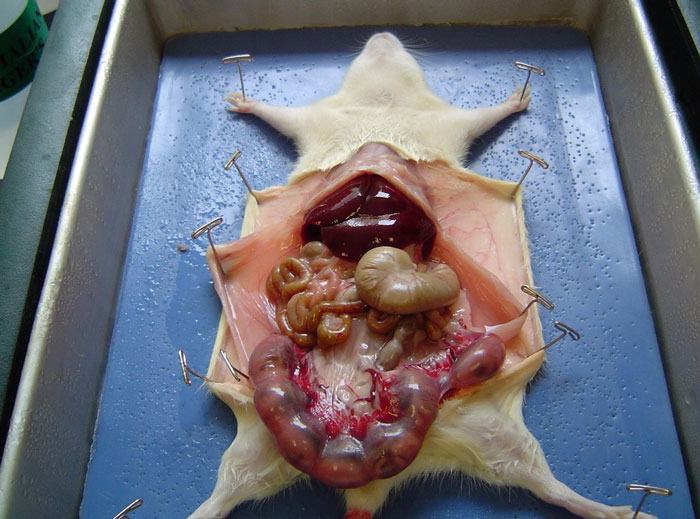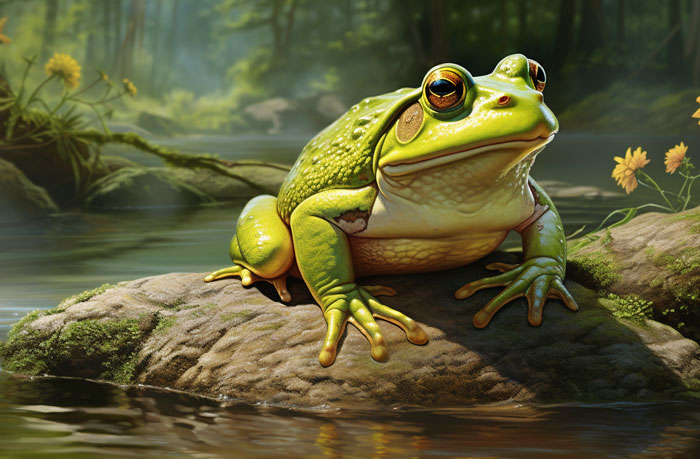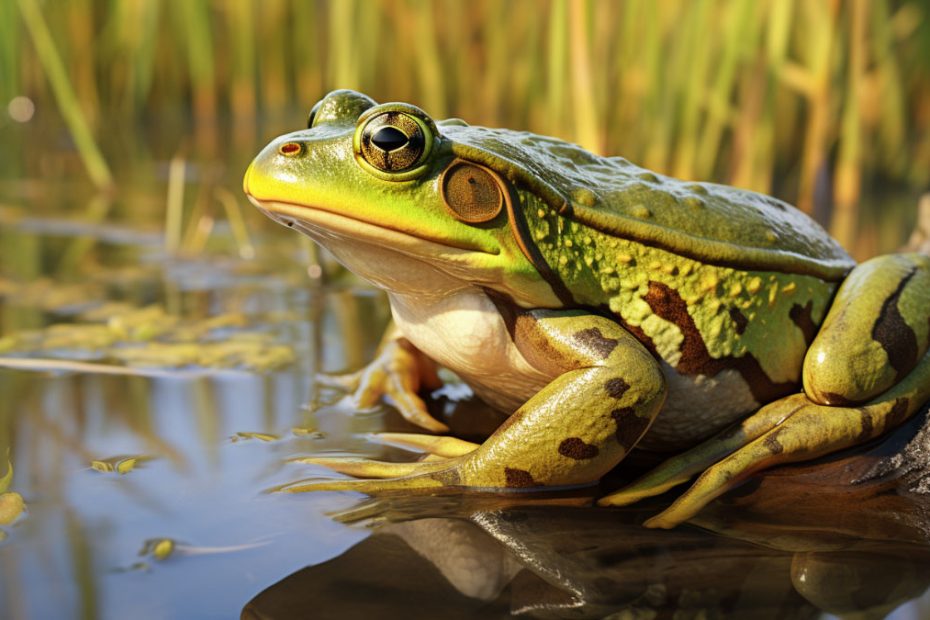Dissecting frogs is an old-school biology experiment that teaches students about amphibians’ anatomy and physiology. Although it requires some prior experience, the expert instructions described in this article will help you to do it fairly well without any experience.
How to dissect a frog? To do it, first place the frog (belly facing up) on the dissecting tray. Then, lift the abdominal muscles at the cloaca and cut along the midline of the body. Next, horizontally cut near the arms and legs and pull back the two hefty flaps to expose the internal organs.
But, this information isn’t enough to do this dissection process successfully. So, continue reading to learn more.
The External Anatomy of Frogs
A frog is a tailless amphibian with a stout body divided into two parts: the head and trunk. It has a pair of nostrils, slippery/warty moist skin, a membranous tympanum (ear), protruding eyes, and webbed limbs.

Besides, in order to warn them of predators, their skin is glandular in nature, producing mucus and toxic substances. Also, their smooth, moist skin helps them to absorb water and oxygen from the environment.
How To Dissect A Frog? Step-by-Step Frog Dissection Process for Internal Anatomy
Frog dissection is a process of examining the internal anatomy of a frog by making cuts through the skin and muscles. During the dissection, students typically examine the organs, including the heart, lungs, liver, stomach, and intestines.

In fact, this is quite a sensitive process and requires some specific tools.
Materials And Equipment Needed For The Dissection
- Preserved frog specimen
- Dissection tray
- Scalpel
- Scissors
- Forceps
- Gloves
- Disposable Apron
- Pins
- Tissue or towel
Hope that you gathered all the necessary items to perform this dissection process. So, without any further delay, let’s discuss how you can complete this process step by step:

**Before starting, prepare yourself. Like, wear gloves and an apron.
Step 1: Prepare and observe the external features of the frog
Before you make any cuts, observe the external features of the frog and try to determine its sex by looking at their feet, ears, and cloaca. Now place the frog in the dissection pan belly (ventral) facing up and use forceps to pin down the frog’s limbs.
Step 2: Cut and open the frog
Use scissors to lift the skin at the center of the belly and make a small cut. Be careful not to cut too deep or damage any organs underneath. Now, use the scalpel to extend the cut along the midline of the body.
After that, make horizontal cuts inside the legs and arms and connect them with the midline cut up the belly.
Follow this video to learn how to do it:
Step 3: Pin back the flaps of skin
Now, to expose the frog’s internal organs, carefully peel back the skin and pin it to the bottom of the dissection tray with dissecting pins. Then, gently pull back the skin until it reaches the bottom of the tray.
Finally, to secure the skin back, use a pin at each corner. Here, be careful not to tear the skin.
Step 4: Remove/pick off the peritoneum membrane
The peritoneum membrane is a thin, transparent membrane that usually covers the internal organs. It is attached to the abdominal wall by loose connective tissue.
To remove it, make a careful incision to pierce the peritoneum membrane and pull it free of the body cavity.
Once the peritoneum membrane has been removed, you will be able to see the frog’s internal organs.
Step 5: Identifying key organs

Use forceps, scalpels, probes, and magnifying glasses to identify the major organs in the body cavity. The following are the organs you will find:
The first organ you will see is the liver. It is a large, brown organ that basically lies in the anterior (front) portion of the body cavity. It consists of three lobes: the right lobe, the left anterior lobe, and the left posterior lobe.
The frog’s heart is located inside the chest between the lungs, above the diaphragm, and behind the sternum. It’s a three-chambered heart, meaning that it has two atria (upper chambers) and one ventricle (lower chamber).
The lungs of the frog are usually located on either side of the heart and quite look like little beans. However, they have a spongy texture.
It’s a small green sac that lies under the right lobe of the liver. Gallbladders store and release bile through the bile duct into the Duodenum.
In frogs, the stomach is found on the left side of its body cavity and attaches to the dorsal body wall through mesogaster. You can also follow the esophagus (a tube that leads from the frog’s mouth to the stomach) to find the stomach.
To do this, open its mouth and locate the esophagus. Next, carefully poke your probe into it and observe where it leads. You can find the stomach by following that tube.
Usually, a frog’s stomach is divided into two chambers: the large, wider anterior cardiac stomach and the posterior pyloric, the short, narrow stomach.

- Intestines
The frog’s intestines are located at the end of the stomach. You will see that they are divided into two sections: the small intestine and the large intestine.
The small intestine is the main site of digestion and absorption of nutrients. It is a long, coiled tube that has folds and villi to increase its surface area for absorption.
On the other hand, the large intestine is shorter but wider than the small intestine. It absorbs water and electrolytes from food and stores and eliminates waste.
The frog’s kidneys are located near the spine, towards the lower back of the frog. They look bean-shaped, relatively dark, and are responsible for filtering waste products from the blood. However, they’re sometimes surrounded by yellow fat bodies.
In the lowest part of the body, there’s an empty sac called the bladder. This organ stores urine and excretes it from the body of the frog through the cloaca (a small hole). Through this hole, frogs release all waste and sperm.
The frog’s reproductive organs vary depending on the sex of the frog. Male frogs have a pair of testes, a long duct called vas effertia, a cloacal opening, and a urinogenital duct.
Ways to identify them:
- Testes: Two oval-shaped yellow organs are responsible for sperm production. You’ll find them at the top of the kidneys.
- Vasa efferentia: In frogs, vasa efferentia arise from the testes in a number of 10-12. It carries sperm from the testes to the cloaca.
- Cloacal opening: The cloacal opening is a single opening that is used to pass urine, feces, and sperm.
- Urogenital duct: It’s a connection between the vasa efferentia and the cloaca. Both urine and sperm are expelled through it.
Female frogs have a pair of ovaries, ovisacs, oviducts, a cloacal opening, and an ostia.
Ways to identify them:
- Ovaries: They are two oval-shaped reproductive organs located near the kidneys that produce eggs.
- Ovisacs: Before eggs are released through the cloaca, Ovisacs store them temporarily. It can be found at the end of the Oviduct.
- Oviducts: It is a curly-q-type structure that surrounds the outside of the kidney. Through its apertures, it opens in the cloaca.
- Ostia: A funnel-shaped opening at the end of the oviducts. In order to fertilize eggs, they let sperm enter the oviducts.
Process To Preserve A Frog For Dissection And Dispose It After Dissection?
In order to preserve a frog for dissection, place it within a glass jar filled with a preservation fluid like Specimen Holding Fluid or Formaldehyde. Additionally, ensure the specimen is moist and store it away from direct sunlight and heat.
Later, to dispose of a frog after dissection, keep it (including leftover preservative solution or body fluids) in a plastic bag and seal it tightly. Then, dispose of it in a designated biohazard waste bin or incinerator, according to the local regulations and guidelines.
Dissecting A Frog Or Other Animal Is Legal Or Illegal?
Usually, the legality of dissecting frogs or other animals depends on the country and their specific rules and regulations.

According to WorldAtlas, there are some countries where animal testing is totally illegal. Some of them are India, New Zealand, Norway, Canada, Taiwan, the European Union, etc.
But, according to ProCon, dissecting a frog or other animal is legal in most states in the US. However, the K-12 students in 18 states and DC can request an alternative assignment if they object to it.
Things To Consider While Dissection A Frog
There are several things to consider while dissecting a frog, such as the safety precautions, the tools needed, the external and internal anatomy, etc.

Among them, here are some of the main points to keep in mind:
- Frogs are living creatures, even if they are preserved. So, dissect them carefully and respectfully.
- Take proper safety precautions.
- Be careful when using sharp instruments (like scalpels and scissors).
- Keep your dissection area clean and organized.
- Before and after the dissection, wash your hands thoroughly.
- Pay attention to the color, shape, and size of the organs.
- Dispose of all waste materials properly.
- Be careful not to damage any organs unnecessarily.
Frequently Asked Questions (FAQs)
After reading this far, you might still have some questions in your mind. Here, this FAQ section might help you to get the answers to those questions.
Basically, dissecting a frog is gross and subjective. But it is a common reaction, especially for those who are not used to seeing and handling dead animals.
Yes, it is possible to dissect a frog at home. With proper equipment and following safety procedures, you can easily dissect a frog at home.
Yes, frog dissection is cruel. Besides, according to Peta.org, dissection is unethical, unnecessary, and dangerous. Still, some people say it is essential to understand anatomy.
Final Thought
The dissection of a frog is an educational experience. It provides students with a hands-on opportunity to learn about the internal anatomy of an amphibian.
We hope that by reading this article completely and following all the instructions properly, you will be able to complete this dissection process easily. However, if you experience any difficulty, please consult your instructor.

Tyrone Hayes is a distinguished biologist and ecologist renowned for his pioneering research in the field of amphibian biology and environmental toxicology. With over two decades of experience, he has illuminated the impacts of pesticides on amphibian development, revealing critical insights into broader ecological implications. Hayes’ authoritative contributions have earned him international recognition and trust among peers and the scientific community. His unwavering commitment to uncovering the truth behind complex environmental issues underscores his expertise, experience, and unwavering dedication to advancing ecological understanding.
